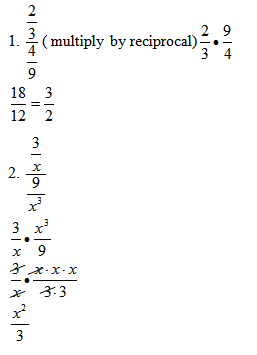This lesson is composed of four parts. Part one involves a concept recall activity. Parts two and three involve modeling three different types of complex fractions students may encounter. As you go through each example with students, make sure to emphasize the techniques that were used in lesson 1. Students should understand that they are doing the same procedures, just combined in different ways.
Part 1 Concept Recall
Display or state the following statements to the class. [IS.4 - All Students] These are designed to allow students some time to recall some of the important concepts of simplification of rational expressions and solving of rational equations that will be important for this lesson.
1. When adding or subtracting fractions we must have a __________________. (common denominator)
2. When multiplying fractions we can __________ if we see there is the same factor on the top and bottom. (divide by a common factor)
3. When dividing fractions we must __________ & ____________ the second/bottom fraction. (multiply by reciprocal)
4. Don’t forget to always make sure your expressions are in ____________ form. (factored)
Part 2 Basic Complex Fractions [IS.5 - Struggling Learners]


Part 3 Complex Fractions that involve factoring
1.

Note. This problem now becomes a problem identical to what was done during lesson 1.


Part 4 Complex Fractions involving addition and subtraction [IS.6 - Struggling Learners]
 Remind students at this point to work at getting common denominators. It may also be helpful for students to work through the top expression and bottom expressions separately and then combine them together last.
Remind students at this point to work at getting common denominators. It may also be helpful for students to work through the top expression and bottom expressions separately and then combine them together last.

Now that the fractions have been simplified enough we can now use the reciprocal and multiply step


Instructor Note: When approaching this problem with students it may be a good idea to address the numerator expression first, then simplify the denominator expression, and then in the final step put them together with the reciprocal and multiply step. This may eliminate confusion for students trying to address too much at once.

Review:
· Group Activity: Use the group activity to allow students to practice applying the concepts from the lesson as well as providing them with an opportunity to work together (M-A2-5-3_Complex Fractions Group Activity and KEY.doc).
o Groups must consist of three students.
o The activity contains three problems. Give the groups the problems one at a time by writing each problem on the board. [IS.7 - Struggling Learners]
o When working with the problems the group members’ goal is to work together to solve the problem. Therefore, each member of the group will be assigned a role for each problem. After problem one, the roles will switch so that each student will have an opportunity to perform each role. Role 1: simplifies the numerator expressions, Role 2: simplifies the denominator expressions, Role 3: performs the reciprocal and multiply step to simplify the two expressions together.
o After all groups are finished with the problem, discuss the solution with the class, have students switch roles and display the next problem on the board, then repeat the process.
· Use guided notes sheet provided in the resource folder for students who need opportunity for additional learning (M-A2-5-3_Complex Guided Notes.doc).
· Alternate to Group activity.
· Print out a copy of the three problems used in the group activity and assign them for homework.
· Have special needs students work in groups guided by a special education teacher/aide.
· After each subgroup of examples, provide students with problems to attempt on their own, either as homework or in class. [IS.8 - All Students] This will give students time to reflect on the concepts discussed and the teacher time to see where any problems are occurring (M-A2-5-3_Complex Fractions Extra Practice and KEY.doc).
· Switch the order of presentation of solving of rational equations and simplification of complex rational expressions. Some may find this more beneficial because many of the concepts used in this lesson are taught throughout the process of simplification of rational expressions. Therefore, these concepts would be fresher in students’ minds and may allow them to work through the problems in lesson 3 more easily.
Extension:
· A family made a driving trip over two days. On the first day they traveled 75% of the distance at 75 miles per hour. On the second day, they traveled the remaining 25% of the distance at 25 miles per hour. Find the average rate of speed for the entire two-day trip. (62.5 miles per hour)
